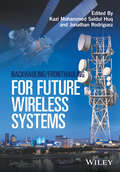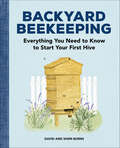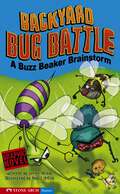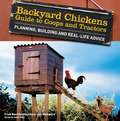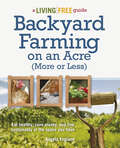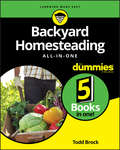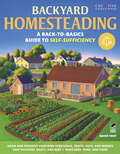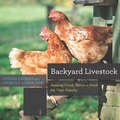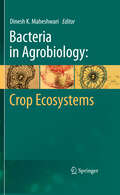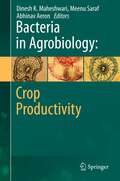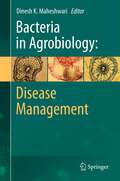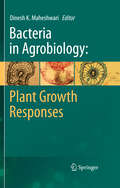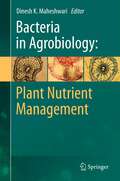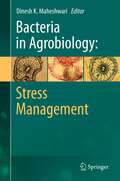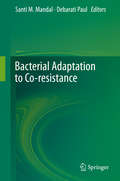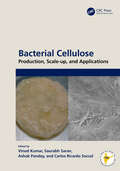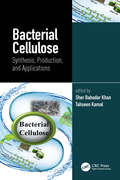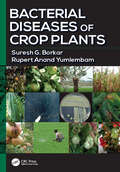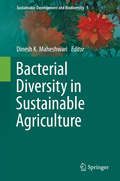- Table View
- List View
Backhauling/Fronthauling for Future Wireless Systems
by Jonathan Rodriguez Kazi Mohammed HuqThe recent widespread use of mobile Internet together with the advent of numerous smart applications has led to the explosive growth of the mobile data traffic in the last few years. This momentum of mobile traffic will continue due to the emerging needs of connecting people, machines, and applications through mobile infrastructure. As a result, the current and projected dramatic growth of mobile data traffic necessitates the development of fifth-generation (5G) mobile communications technology. As a result, there is significant interest in the development of innovative backhaul and fronthaul solutions for ultra-dense heterogeneous networks. This book brings together mobile stakeholders from academia and industry to identify and promote technical challenges and recent results related to smart backhaul/fronthaul research for future communication system such as 5G. Moreover, it presents a comprehensive analysis on different types of backhaul/fronthaul technology and topology. It considers already available topology for backhauling/fronthauling and explains all fundamental requirements for deploying future smart and efficient backhauling/fronthauling infrastructure from an architectural, technical and business point of view and presents real life applications and use cases. Expanding on standardization activities, this book consists of multiple channels on specific research topics. The chapters are logically organized as the authors approach the subject from overview to specifics and from a lower to higher layer direction.
Backscattering and RF Sensing for Future Wireless Communication
by Qammer H AbbasiDiscover what lies ahead in wireless communication networks with this insightful and forward-thinking book written by experts in the field Backscattering and RF Sensing for Future Wireless Communication delivers a concise and insightful picture of emerging and future trends in increasing the efficiency and performance of wireless communication networks. The book shows how the immense challenge of frequency saturation could be met via the deployment of intelligent planar electromagnetic structures. It provides an in-depth coverage of the fundamental physics behind these structures and assesses the enhancement of the performance of a communication network in challenging environments, like densely populated urban centers. The distinguished editors have included resources from a variety of leading voices in the field who discuss topics like the engineering of metasurfaces at a large scale, the electromagnetic analysis of planar metasurfaces, and low-cost and reliable backscatter communication. All of the included works focus on the facilitation of the development of intelligent systems designed to enhance communication network performance. Readers will also benefit from the inclusion of: A thorough introduction to the evolution of wireless communication networks over the last thirty years, including the imminent saturation of the frequency spectrum An exploration of state-of-the-art techniques that next-generation wireless networks will likely incorporate, including software-controlled frameworks involving artificial intelligence An examination of the scattering of electromagnetic waves by metasurfaces, including how wave propagation differs from traditional bulk materials A treatment of the evolution of artificial intelligence in wireless communications Perfect for researchers in wireless communications, electromagnetics, and urban planning, Backscattering and RF Sensing for Future Wireless Communication will also earn a place in the libraries of government policy makers, technologists, and telecom industry stakeholders who wish to get a head start on understanding the technologies that will enable tomorrow's wireless communications.
Backyard Beekeeping: Everything You Need to Know to Start Your First Hive
by David Burns Sheri BurnsA how-to guide for a thriving hive—right in your own backyardThe benefits of keeping bees are abundant: pollination in gardens, a fresh supply of honey, and the knowledge that you're supporting creatures fundamental to a healthy ecosystem. This guide will help make backyard beekeeping for beginners a breeze, with the tools and sound advice you need to plan your first colony, care for your bees, and enjoy the harvest.Suit up and get buzzing with an overview of some of the gear you'll need and guidance for choosing the right hive. Find step-by-step instructions on hive assembly as well as advice on installing and feeding your bees. Learn when and how to inspect the hive, including tips on keeping your bees happy and healthy, and walkthroughs of different harvesting techniques.New bees on the block—Build a thriving backyard beehive with advice for planning outdoor space, planting the best blooms for a bee-friendly garden, and caring for your hive throughout the seasons.What's the buzz—Explore a variety of beekeeping approaches and methods, like natural vs. medicated, the differences among popular hive types, and tips for preventing swarming.Sweet as honey—From Chile-Infused Honey and Honey Lemon Garlic Salmon to Beeswax Candles and Healing Herbal Salves, you'll find 15 delicious honey-based recipes as well as more than a dozen creative uses for beeswax.With this guide, you'll have the head start you need to be a successful backyard beekeeper.
Backyard Biodiesel
by Lyle Estill Bob ArmantroutSmall-scale home biodiesel production holds a singular attraction for the do-it-yourself enthusiast. While perhaps it can't save the world, this unique renewable fuel is economical, fun to make, better for the environment, and will help you reduce your dependence on Big Oil. And getting started is easier than you think.Backyard Biodiesel is written by two recognized experts in the field of small-scale biofuels. This comprehensive hands-on, practical, DIY guide includes: The basics of small-scale brewing--recipes, strategies, and technologies Advanced backyard analytics and troubleshooting Safety considerations and regulatory issues Topping up the tank--how to put your biodiesel to work for youMaking your own fuel is not only possible, it is rewarding. Designed to be accessible to everyone from readers with no prior technical expertise to alternative energy buffs, Backyard Biodiesel is a must-read for any aspiring brewer, packed with everything you need to get up and running quickly and safely.Lyle Estill is the president and co-founder of Piedmont Biofuels and the author of Industrial Evolution, Small is Possible, and Small Stories, Big Changes. He has won numerous awards for his commitment to sustainability, outreach, community development, and leadership.Bob Armantrout helped to manage four commercial biodiesel plants before joining Piedmont Biofuels in 2007. He works as an instructor at Central Carolina Community College, where he spearheads an innovative two-year biofuels degree program.
Backyard Bug Battle: A Buzz Beaker Brainstorm (A Buzz Beaker Brainstorm)
by Scott NickelBuzz spills an invention of his Dad's super-fast grow juice, and creates gigantic insects and flowers. Written in graphic-novel format.
Backyard Chickens' Guide to Coops and Tractors: Planning, Building, and Real-Life Advice
by Members of Backyard Chickens.comKeeping chickens isn't just for farms! The backyard chicken revolution has coops popping up in neighborhoods all over. Home-raised chickens provide a great source of superior, organic eggs that are as close as your backyard. Chickens also make good pets and provide free fertilizer-and lots of fun. Backyard Chickens Guide offers plans and photos for 16 custom coops built by real chicken owners, (including three portable designs known as tractors). Read their stories and learn from their experiences, then head out to the backyard to start your own flock.
Backyard Farming on an Acre: Eat Healthy, Save Money, and Live Sustainably in the Space You Have (A Living Free Guide)
by Angela EnglandFor urban and country dwellers alike, a quarter acre is all the space you need to farm all the food you need! Homesteading allows you to feed your family healthy meals harvested right from your own backyard while also reducing your environmental footprint.Live off the land you have. Plant a successful and sustainable farm—on a quarter acre to a full acre and beyond—where you can raise your own fruits, vegetables, chickens, bees, milk-bearing animals, and more. Local, organic food is attainable to you at a fraction of the cost with your own self-contained operation.Angela England runs her family&’s successful, small-scale farm, and she teaches you how you can do the same. Backyard Farming on an Acre (More or Less) guides you through the essentials of planning a small farm—decide what should be grown or raised, and implement proven and sustainable homesteading techniques. Learn everything you need to know to maximize your space, yield, and harvest. It&’s not glamorous, but it is rewarding, so prepare to get a little dirt under your fingernails and see what kind of gardening and farming magic you—and your land!—are capable of.
Backyard Farming: How to Plan, Build, and Maintain Your Own Compost System for a Healthy and Vibrant Garden (Backyard Farming #11)
by Kim PezzaYour Backyard Farming Experience Begins Here!Give Back to Your Garden by Composting!Backyard Farming: Composting is your all-in-one guide for creating your own homestead composting plan and adding rich, nourishing humus to your garden. This guide reviews every important topic from what should and should not be composted, benefits and uses for compost, how to build a compost bin, and much more.Whether you’re composting the waste from your farm or just the scraps from your kitchen, Composting is the comprehensive primer for anyone looking to start composting and bring that “black gold” to their own garden. Including detailed instructions and informative photographs that help ensure your compost system is practical and productive, Composting takes you step by step through everything you need to nourish your garden—and build healthy, rich soil.With Composting, you will:• Choose the composting method that works best for you, your needs, and your available material• Discover how to begin a compost system and how to maintain it for optimal yield• Construct your own composting system from a variety of easy-to-follow plans• Learn how to troubleshoot any problem your compost pile might develop• Find out how best to use your compost—including indoor container gardening...and much more to help you achieve success.More than ever, people everywhere are making a return to a self-sufficient, sustainable lifestyle. Join the growing movement of homemakers looking to a healthier, happier way of life—and it starts right in your very own backyard.Backyard Farming is a series of easy-to-use guides to help urban, suburban, and rural dwellers turn their homes into homesteads. Whether planning to grow food for the family or for sale at the local farmers market, Backyard Farming provides simple instruction and essential information in a convenient reference.
Backyard Homesteading All-in-One For Dummies
by Todd BrockLive a more sustainable lifestyle Historically referred to as a government program for revitalizing undesirable living areas, "homesteading" today has come to mean the pursuit of a self-sufficient lifestyle. Homesteading can include everything from keeping bees, growing vegetables, and composting to installing solar panels, creating a rain barrel, and canning your own food,—plus much more. Backyard Homesteading All-in-One For Dummies has a little bit of everything for the homesteader in all of us. It walks you through the basics of creating your own sustainable homestead and offers expert tips and tricks for making it as easy and successful as possible. Raise chickens Keep bees Compost Can and preserve This book gives you everything you need to embark on your own homesteading adventure.
Backyard Homesteading: A Back-to-Basics Guide to Self-Sufficiency (Gardening Ser.)
by David TohtA simple guide to growing fruits, vegetables, nuts & berries, raising chickens, goats, & bees, and making beer, wine, & cider from your backyard.If you want to take control of the food you eat and the products you use, Backyard Homesteading will help you learn how to do it—even if you live in an urban or suburban house on a typical-size lot. Inside, you’ll discover how to turn a yard into a productive and wholesome “homestead” that allows you to grow your own fruits and vegetables and raise farm animals, including chickens and goats. You’ll also find the laws and regulations of raising livestock in populated areas, as well as ways to use and preserve the bounty your land produces.GETTING STARTEDBenefits of pure foodFamily recreationLocal regulationsPotential yields and savingsRAISING VEGETABLES AND HERBSGarden planning/layoutStructures/irrigationVegetable profilesPlanting techniquesComposting/healthy soilSeasonal gardeningGROWING FRUITS, BERRIES, AND NUTSPlanting fruit trees and bushesFruit profilesOrganic pest controlGrafting and pruningHarvesting methodsRAISING CHICKENSThe joy of chickensCollecting eggsCare and feeding tipsOther small animalsRAISING GOATSBenefits of goat milkStructures/fencingCare and feeding tipsOther large animalsBEEKEEPINGBenefits of beekeepingCare and harvestingBuilding hivesCollecting honeyHARVEST HOMECanning/drying/freezingMaking beer, wine, ciderMaking jerky, sausageMaking jams, jelliesPickling/salting/smokingBuilding root cellars
Backyard Livestock: Raising Good, Natural Food For Your Family (Countryman Know How #0)
by Steven Thomas George B. LoobyA new edition of the essential guide to animal husbandry Have you ever celebrated Thanksgiving with a turkey from a local farm, instead of a packaged, frozen supermarket bird? Ever cracked a farm-fresh egg into the skillet next to a store-bought one? The difference in quality can’t be overstated. Small-scale livestock farming not only brings better, safer, and more delicious food to your table, but it can do so economically. Long the primary reference for anyone who keeps animals as a sustainable food source, this latest edition comes with a beautiful new design and includes up-to-date information on breeding, feeding, disease prevention, housing, and management. Complete with clarifying diagrams, full color photography, and a catalog of supplemental reading, Backyard Livestock continues to be the best resource for those who wish to sustainably and ethically raise their own farm-fresh food.
Bacteria in Agrobiology: Crop Ecosystems
by Dinesh K. MaheshwariThe future of agriculture strongly depends on our ability to enhance productivity without sacrificing long-term production potential. An ecologically and economically sustainable strategy is the application of microorganisms, such as the diverse bacterial species of plant growth promoting bacteria (PGPB). The use of these bio-resources for the enhancement of crop productivity is gaining worldwide importance. Bacteria in Agrobiology: Crop Ecosystems describes the beneficial role of plant growth promoting bacteria with special emphasis on oil yielding crops, cereals, fruits and vegetables. Chapters present studies on various aspects of bacteria-plant interactions, soil-borne and seed-borne diseases associated with food crops such as rice, sesame, peanuts, and horticultural crops. Further reviews describe technologies to produce inoculants, the biocontrol of post harvest pathogens as a suitable alternative to agrochemicals, and the restoration of degraded soils.
Bacteria in Agrobiology: Crop Productivity
by Dinesh K. Maheshwari Abhinav Aeron Meenu SarafThe future of agriculture greatly depends on our ability to enhance productivity without sacrificing long-term production potential. The application of microorganisms, such as the diverse bacterial species of plant growth promoting rhizobacteria (PGPR), represents an ecologically and economically sustainable strategy. The use of these bio-resources for the enhancement of crop productivity is gaining importance worldwide. Bacteria in Agrobiology: Crop Productivity focus on the role of beneficial bacteria in crop growth, increased nutrient uptake and mobilization, and defense against phytopathogens. Diverse group of agricultural crops and medicinal plants are described as well as PGPR-mediated bioremediation leading to food security.
Bacteria in Agrobiology: Disease Management
by Dinesh K. MaheshwariThe future of agriculture greatly depends on our ability to enhance productivity without sacrificing long-term production potential. The application of microorganisms, such as the diverse bacterial species of plant growth promoting bacteria (PGPB), represents an ecologically and economically sustainable strategy. The use of these bio-resources for the enhancement of crop productivity is gaining importance worldwide. "Bacteria in Agrobiology: Disease Management" discusses various aspects of biological control and disease suppression using bacteria. Topics covered include: fluorescent pseudomonads; siderophore-producing PGPR; pseudomonas inoculants; bacillus-based biocontrol agents; bacterial control of root and tuber crop diseases; fungal pathogens of cereals; soil-borne fungal pathogens; peronosporomycete phytopathogens; and plant parasitic nematodes.
Bacteria in Agrobiology: Plant Growth Responses
by Dinesh K. MaheshwariThe future of agriculture strongly depends on our ability to enhance productivity without sacrificing long-term production potential. An ecologically and economically sustainable strategy is the application of microorganisms, such as the diverse bacterial species of plant growth promoting bacteria (PGPB). The use of these bio-resources for the enhancement of crop productivity is gaining worldwide importance. "Bacteria in Agrobiology: Plant Growth Responses" describes the application of various bacteria in plant growth promotion and protection, including symbiotic, free living, rhizospheric, endophytic, methylotrophic, diazotrophic and filamentous species.
Bacteria in Agrobiology: Plant Nutrient Management
by Dinesh K. MaheshwariThe future of agriculture strongly depends on our ability to enhance productivity without sacrificing long-term production potential. An ecologically and economically sustainable strategy is the application of microorganisms, such as the diverse bacterial species of plant growth promoting bacteria (PGPB). The use of these bio-resources for the enhancement of crop productivity is gaining worldwide importance. "Bacteria in Agrobiology: Plant Nutrient Management" focus on the management of plant nutrient to support plant growth and development. The topics treated in this book include mechanisms of plant growth promoting rhizobacteria, zinc and phosphate solubilizing microorganisms, sulfur oxidizing bacteria, ACC deaminase, siderophores, phytohormones, quorum-sensing, biofilms, antibiotics, volatiles, denitrification and integrated nutrient management.
Bacteria in Agrobiology: Plant Probiotics
by Dinesh K. MaheshwariThe future of agriculture strongly depends on our ability to enhance productivity without sacrificing long-term production potential. An ecologically and economically sustainable strategy is the application of microorganisms, such as the diverse bacterial species of plant growth promoting bacteria (PGPB). The use of these bio-resources for the enhancement of crop productivity is gaining worldwide importance. "Bacteria in Agrobiology: Plant Probiotics" discusses the current trends and future prospects of beneficial microorganisms acting as Probiotics. Topics include the application for the aboveground fitness of plants, in mountain ecosystems, in tropical and Mediterranean forests, and in muga sericulture. Further aspects are Arabidopsis as a model system for the diversity and complexity of plant responses, plant parasitic nematodes, nitrogen fixation and phosphorus nutrition.
Bacteria in Agrobiology: Stress Management
by Dinesh K. MaheshwariThe future of agriculture strongly depends on our ability to enhance productivity without sacrificing long-term production potential. An ecologically and economically sustainable strategy is the application of microorganisms, such as the diverse bacterial species of plant growth promoting bacteria (PGPB). The use of these bio-resources for the enhancement of crop productivity is gaining worldwide importance. "Bacteria in Agrobiology: Stress Management" covers the major aspects on PGPR in amelioration of both abiotic and biotic stresses. PGPR mediated in priming of plant defense reactions, nutrient availability and management in saline and cold environment, hormonal signaling, ACC deaminase and its role in ethylene regulation under harsh conditions are suitably described.
Bacterial Adaptation to Co-resistance
by Santi M. Mandal Debarati PaulThe proposed book aims to understand the mechanism of survival of microorganisms in response to chemical stress in various ecological niches that suffer direct human intervention, more so the agricultural, domestic and hospital settings. Microbicides (e.g. disinfectants, antiseptics, fungicides, algaecides, insecticides and pesticides) are used rampantly to control undesirable microbes. Insecticides and pesticides are routinely used in agriculture which directly affect the microbial population in farms, orchards and fields. Health care environments are always stressed with disinfectants and antibiotics. It is always probable that microbicide-stressed microorganisms are in a dynamic state, displaced from one niche to the other. Some soil and water borne bacteria or their resistance determinants are also getting prominence in hospital settings after suffering selective pressure from agricides. In order to reveal the survival strategies of microbicidal-resistant microbes, it is of prime importance to know the mode of action of these complete range of microbicides (agricides to antibiotics). The present book intends to address these issues. There will be several chapters dealing with tolerance and cross resistance in microbes and bacteria in particular, dwelling in various niches. Till date, there is no consensus among scientists in theorizing molecular mechanisms to explain bacterial tolerance and their cross resistance to agricides and antibiotics.
Bacterial Cellulose: Production, Scale-up, and Applications
by Vinod Kumar Carlos Ricardo Soccol Ashok Pandey Saurabh SaranThis reference book provides updated information on the production and industrial significance of bacterial cellulose. Bacterial cellulose is a natural fiber produced by certain microbes, mainly bacteria which belong to the Acetobacter genera. The book discusses its applications in different industrial sectors, such as food, pharmaceutical, energy, and wastewater treatment. It covers the production of cellulose from conventional and renewable feedstock and includes topics such as downstream processing, characterization, and chemical modification of bacterial cellulose. FEATURES Addresses the challenges of the production technologies of bacterial cellulose up to pilot scale Discusses cost-effective green processes using agri-processing residues and medium formulation Includes efficient preparation of nanocomposites using in vitro and in vivo methods Provides the latest applications of bacterial cellulose in the food and pharmaceuticals fields Reviews the production of bacterial cellulose from conventional feedstock such as sugars and starches This book is designed for industry experts and researchers of applied microbiology, bioprocesses, and industrial microbiology.
Bacterial Cellulose: Sustainable Material for Textiles (Sustainable Textiles: Production, Processing, Manufacturing & Chemistry)
by Subramanian Senthilkannan Muthu R. RathinamoorthyThis book presents the potential of bacterial cellulose in the textile and fashion industry. Most of the earlier work on the bacterial cellulose was focused on the bio technology application of cellulose, but the recent urge for the need of a sustainable material in the fashion and textile industries identified the scope of the bacterial cellulose in this aspect. The unique feature of this book is that it relates the bio technological aspects of bacterial cellulose with the sustainable issues in the fashion industry.
Bacterial Cellulose: Synthesis, Production, and Applications
by Sher Bahadar Khan Tahseen KamalBacterial cellulose (BC) is a natural polymer produced by different microbial cells. Its unique structural, physico-chemical, mechanical, thermal, and biological properties offer much potential for use in diverse applications in the biomedical, electronics, energy, and environmental fields, among others. This text provides an overview of the synthesis, characterization, modification, and application of BC. • Discusses sources, characterization, and biosynthesis of BC • Covers composites and aerogels based on BCs • Describes development of BCs from waste and challenges in large-scale production of BCs • Explores a variety of applications such as environmental, industrial, and biomedical This book will be of great interest to researchers and industry professionals in materials science, chemical engineering, chemistry, and other related fields seeking to learn about the synthesis and application of this important material.
Bacterial Communication in Foods (SpringerBriefs in Food, Health, and Nutrition)
by Marco Gobbetti Raffaella Di CagnoIt is generally assumed that microorganisms synthesize, release, detect and respond to small signaling hormone-like molecules. These molecules are used for a process termed "quorum sensing" (QS), a phenomenon that enables bacteria to sense when the minimal number of cells, or "quorum," is achieved for a concerted response to be initiated. Words such as "language" and "behavior" are frequently used to depict QS in the literature. More simply put, language and cross-talk between bacteria, and between bacteria and animal or plant hosts, determines the behavior (e.g., beneficial or pathogenic effects) of bacteria. Currently, the major concern is to understand and decode this language. Overall, bacterial cross-talk was mainly studied on environmental, plant, and human pathogenic bacteria. Few studies considered food-related lactic acid bacteria. The cross-talk between bacteria influences the behavior and, in turn, the environmental adaptation and phenotypes. Therefore, it is understood that bacterial cross-talk has important applicative repercussions. The language spoken between bacteria populating the same food ecosystem may condition the phenotypic traits of starter lactic acid bacteria and, consequently, their performance. This Brief aims to define the basis of cell-to-cell signalling in food fermentation and will highlight: (i) microbiology, nutritional, chemical and functional aspects; (ii) functional properties due to microbial adaptation to the gastrointestinal tract; (iii) principal phenotypes under control of QS circuitries; (iv) quorum quenching. This Brief will be the first reference on this topic and it will highlight the main results for a more productive industrial application. Draft content 1. Signals of food related Gram-negative and Gram-positive bacteria The chapter will describe the different signaling languages used by Gram-negative bacteria (N-acyl-L-homoserine lactones) and Gram-positive bacteria (based on the synthesis of post-translationally modified peptides) and the universal chemical lexicon, shared by both Gram-positive and -negative bacteria (autoinducer-2 through the activity of the LuxS enzyme). 2. Phenotypes related to quorum sensing The chapter will describe the bacterial phenotypes, such as virulence, biofilm maturation, bacteriocin synthesis, and secondary metabolite production under control of QS circuitries. 3. Cell-to-cell signalling in fermented food: sourdough The chapter will describe the language spoken between bacteria populating the same food ecosystem (sourdough) and will provide an overview of the conditioned phenotypic traits of starter lactic acid bacteria and, consequently, their performance. 4. Cell-to-cell signalling in fermented food: yoghurt The chapter will describe the language spoken between bacteria populating the same food ecosystem (yoghurt) and will provide an overview of the conditioned phenotypic traits of starter lactic acid bacteria and, consequently, their performance. 5. Probiotic message at the intra-, inter-species and inter-kingdom level The chapter will describe the mechanisms that regulate the interaction between microorganism and host, and the capacity of the microorganism to adapt to environment. Particular reference will also be made to: (i) pathogen inhibition and restoration of microbial homeostasis through microbe-microbe interactions; (ii) enhancement of epithelial barrier function; and (iii) modulation of immune responses. 6. New Perspectives of quorum sensing This chapter will provide an overview of the future perspective regarding quorum sensing, showing that bacterial cross-talk may have important applicative repercussions. It will highlight the interference on the language of QS, which is defined as quorum quenching (QQ). Increasing translation of the bacterial cross-talk has shown that in some environmental circumstances, quenching of the language may occur.
Bacterial Diseases of Crop Plants
by Suresh G. Borkar Rupert Anand YumlembamFood and agriculture is an important component in the development and survival of civilizations. Around half of the world’s population and their economies are influenced by agricultural farm production. Plant diseases take as much as a 30 percent toll of the crop harvest if not managed properly and efficiently. Bacterial diseases of crop plants are important in plant disease scenarios worldwide and are observed on all kinds of cultivated and commercial value plants including cereals, pulses, oilseeds, fruits, vegetables, cash crops, plantation crops, spices, ornamentals and flowering plant, forage crop, forest trees, and lawn grasses. Bacterial diseases are widespread and are difficult to identify and to control. Few pesticides are available for use in control, and many plant pathologists are not well trained in the management of bacterial diseases. Bacterial Diseases of Crop Plants offers concise information on bacterial diseases of crops, proving a valuable asset to students, scientists in industry and academia, farmers, extension workers, and those who deal with crops that are vulnerable to bacterial diseases. The book contains 13 chapters featuring bacterial diseases of individual crops and is illustrated with full color photographs throughout providing amazing characterization of the diseases. It also includes information on bacterial diseases that appear on different crops across the continents, thereby making the content of interest to plant pathologists around the world. Bacterial diseases are of great economic concern, and their importance in overall losses caused by various other pathogens, such as fungi and viruses, is often undermined in developing countries.
Bacterial Diversity in Sustainable Agriculture (Sustainable Development and Biodiversity #1)
by Dinesh K. MaheshwariThe earth's biodiversity is a degree of ecosystem health which is vital to ecology and environmental sustainability. The microbial world is the largest unexplored reservoir. The agro-ecosystem enriched with rhizosphere implicit abundant and species-rich component of microbial diversity. Its global exploration designs a worldwide framework for agricultural sustainability adjoining benefits in its conservation. Agricultural sustainability requires a major share from ecosystem management which is better paid by microbial diversity and conservation. Diversity of bacteria influences plant productivity providing nutrient convenience from soil instead altering per se community and diversity in the rhizosphere where they may influence mechanistic competent and antagonistic micro-flora. The potential species among the diversity are therefore, essential subjective to their maintenance for use around the globe. Microbial population in agro-ecosystem is influenced by stresses, reduce functionality as a component. It is therefore, important to explore secrets of planned strategy so as to unravel the microbial diversity and conservation in agricultural development. Microorganisms are minute, pervasive in nature and alleged as disease host instead tiny recognize as employee of agro-ecosystem, indulge in agricultural development and potential contributor in world of ecological and economical wealth creation. This step pertinently would help to launch scientific motivation needed to support the refrain of microbial diversity and conservation.
